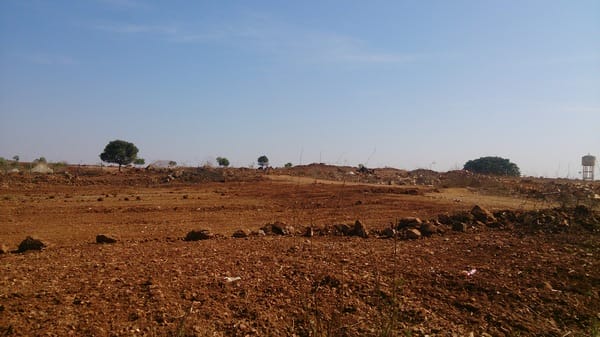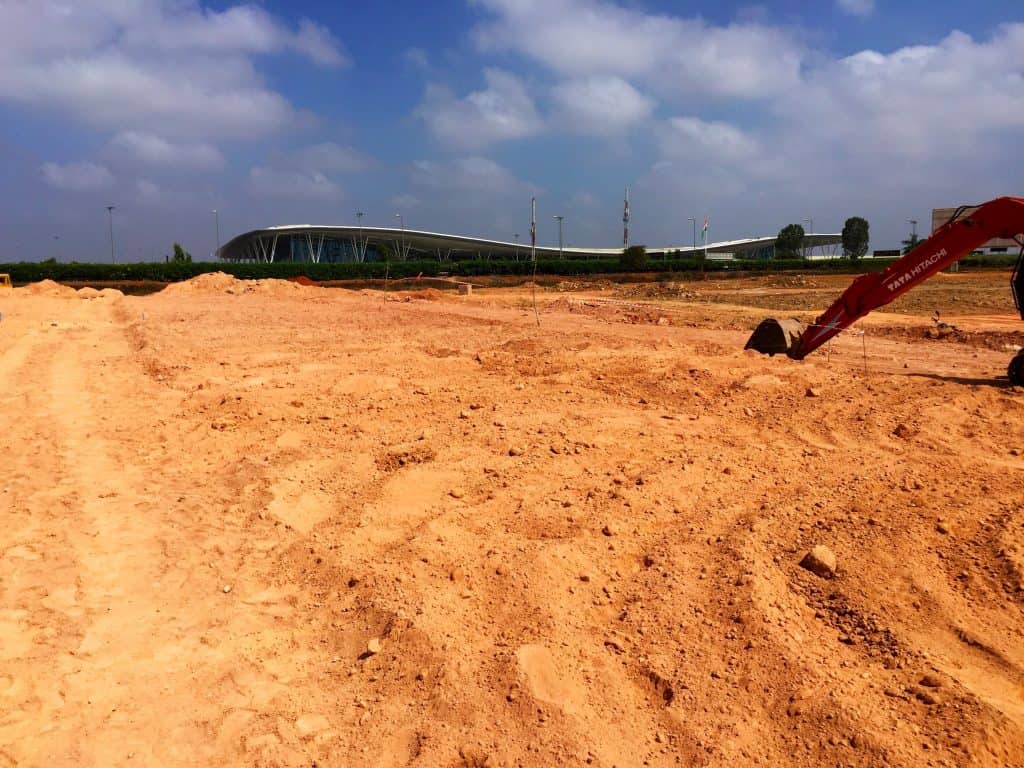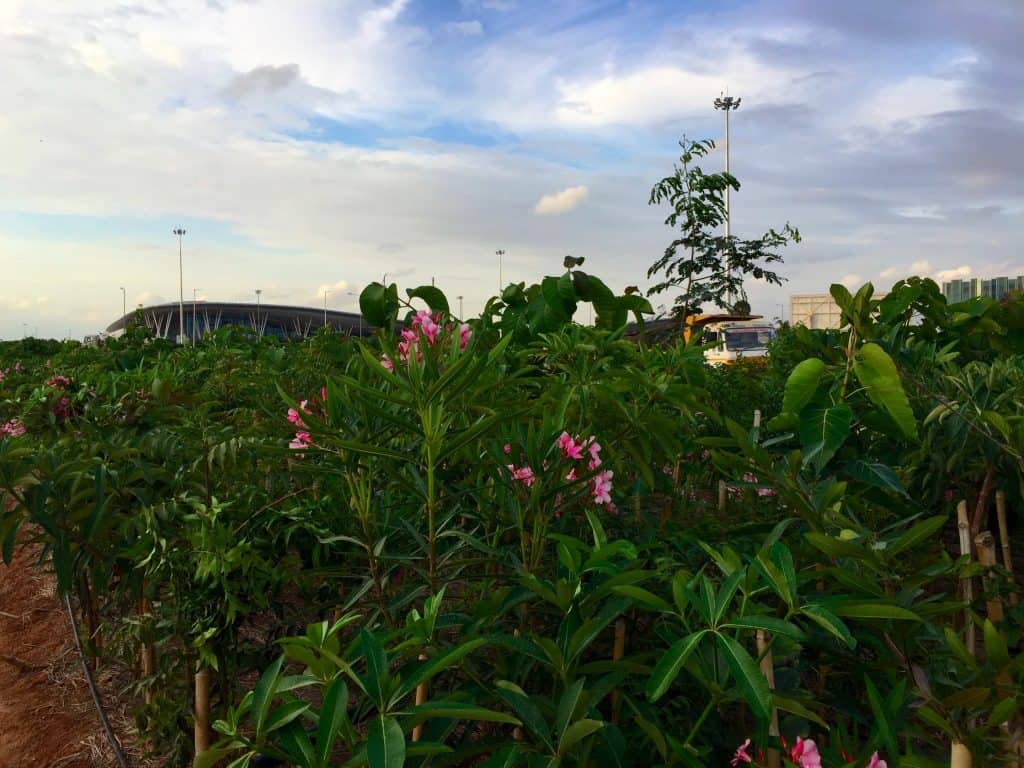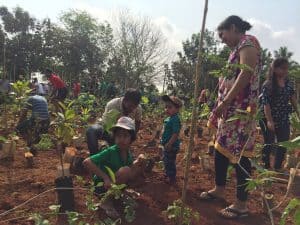This article is supported by SVP Cities of India Fellowship |
Even as green cover in Bengaluru has been steadily declining over the last few decades, some efforts to reverse this phenomena are gathering momentum.
The Government of Karnataka drafted The Karnataka Tree Cover Enhancement Policy, 2016 that targeted increasing forest and tree cover from the current 21% to 33%; in cities planting was to be done in residential and other layouts, institutional lands, private lands, etc.
This policy is yet to be formalised, though the Forest Department has offered to take direct charge of afforestation and tree conservation programmes instead of deputing its officers to BBMP’s toothless Forest Cell, that currently monitors tree cutting and afforestation programmes.
Citizens have become more vigilant and ready to oppose plans to reduce green cover. When the government proposed to upgrade the Queen’s Veterinary Hospital and planned to cut the centuries old trees as part of the project, citizens rose up in protest. Bengalureans also stopped attempts to dilute the Karnataka Tree Preservation Act with an amendment that allowed trees of many species to be cut without permission in 2018.
Citizens and organisations like Afforestt and SayTrees have been working on planting drives; But the question remains: is it enough to pull us back from disaster?
Learning from history
S G Neginhal, who was the Deputy Conservator of Forests in Bangalore between 1982 to 1987 answers the question. The officer who planted 1.5 million trees in the city faced a similar situation where development of the city was creating a deficit in the green cover when he took over the responsibility of reviving it.
“The areas of R T Nagar, Indiranagar, Koramangala were coming up and it was a period of growth in the 80s. I was brought in by the then-Principal Chief Conservator of Forests Shyam Sunder from Thirthahalli. But political will was very important for this to happen. Gundu Rao was the Chief Minister then and the Bangalore Development Authority was just coming up. He summoned the commissioners of both the BDA and the erstwhile Bangalore Mahanagara Palike and asked them how many trees could each of their departments plant in an effort to bring back the green. They responded in numbers of a few thousand and that was nowhere near enough for the city.”
There were other challenges as well. “It isn’t enough that you plant saplings. It is more important you ensure they survive. The problem was that the BMP had planted saplings that were less than 2 feet tall in concrete enclosures. They cost more and did not allow the plants to survive. I chose to plant saplings of indian and exotic variety which were at least 6 feet tall. People who frequented Majestic suddenly found tall saplings on the edge of the road in their area. The problem started when the Palike and the BDA said they’d take over the planting when they had little experience with it. Greening the city became a challenge.”
But how does one protect the green cover in a city where development takes precedence? “Development will always take precedence in an urban setting. That won’t change. The problem is that the civil engineers who lead these projects are taught nothing about environment protection. Road widening is inevitable but when you can save the trees that line the avenue, why cut them down?” he asks.
What is the government doing?
So even as the citizens and private institutions are coming together to help Bangalore save its green cover, the Forest Department is sharing low cost saplings for many species, through its Project Hasiru. Six Forest Department nurseries in Bengaluru are selling the saplings which can be reserved online. If one wants to plant more than 200 saplings, then they can directly contact Dipika Bajpai, Deputy Conservator of Forest for Bengaluru.
Survival rate for saplings planted by the Forest Department is 70%, says Deepika. The Department goes back and replants the saplings where the planted ones didn’t survive. The challenge to tree planting is not the budget or sapling availability, but the lack of land, she adds.
A significant number of trees were cut due to road widening exercises – especially on arterial roads like Sarjapura Road and Kanakapura Road. While other cities from Barcelona to Naya Raipur are creating forests in the middle of the city, Bengaluru’s efforts are focused on street-side planting.
The BMRCL planted 8085 trees on both sides of the road in the ten wards in Bengaluru under compensatory afforestation in 2016-17. BBMP says they planted over 1,20,000 saplings on roadsides.
But the problem with BBMP’s tree planting programme is accountability. Nobody knows how many saplings survive each year. In order to stop this and to help have better tree-cuttting mechanism, BBMP constituted a Forest Cell, which went into hibernation often, with the officers not getting enough support.
Since BBMP Forest Cell does not report to the Forest Department, Deepika Bajpai, the Deputy Conservator of Forest for Bengaluru, says the possibility of bringing Forest Cell under the Forest Department is being considered.
More layouts are being built in Bengaluru and outskirts, but they have not been designed to conserve green spaces. The land on which Kempegowda Layout is being developed was once a green belt; but the trend of 30×40 and smaller sites, crammed together next to each other, don’t leave much area for even a home garden, as pointed out in this article by Rajarama Bhat.

Kempe Gowda Layout. Pic: B V Rajarama Bhat
In a city where land is at a premium, how does one address the problem of shrinking green cover? “If you are going to reduce the open spaces in new layouts, obviously the green cover is going to shrink. You can’t have a shortcut to healthy living,” Neginhal cautions.
Are independent initiatives the answer?
Shubhendu Sharma founded Afforestt in 2011 to build native forests. One of the best examples of their work is a pilot forest in one acres at the Bengaluru airport where they planted 12000 trees. Over the years, they have created 16 forest patches across the city. A new one is coming up in a land owned by the police, near Hosmat hospital.

Airport area before planting. Pic courtesy Afforestt

Airport area after planting. Pic courtesy Afforestt
Structured as a for profit entity, Afforestt also consult, train and help build backyard forests, but have also opened up their processes in an open source model. Till date, Afforest has planted 4.5 Lakhs trees across their 108 projects; 90 of these sites are located in India.
Another initiative Say Trees engages with citizens and corporates. They have helped plant 70,000 trees in Bengaluru from 2008 when founder Kapil Sharma, a software engineer decided to do something about the disappearing greenery.
With the vision of creating patches of forests in and around Bengaluru and green corridors connecting them, Saytrees plants trees in unused or empty spaces in the city, including lakes, government school campuses, etc. Each drive is supported by some corporate, as a CSR activity.

A family hard at work planting saplings on the forest pit. Pic courtesy: Say Trees
Saytrees’ model is simple. On one hand, it brings private organisations with the funds who want to do something for the city, at the same time engage their employees. On the other hand, SayTrees works with the government to get permissions, and themselves organise the logistics of getting the land ready for planting and follow up on maintenance activities. They spend a few months on planning the various drives and get ready for execution by May each year.
Kapil Sharma explains that improving the ecology of our city is not just about planting a bunch of trees and developing lakes. Maintenance plays a critical role.
NGOs like Afforest and SayTrees use the Miyawaki method created by Akira Miyawaki, a Japanese botanist, in afforestation. They plant native species of trees in small areas close to each other creating a diversified natural forest. This method allows for trees to grow 10 times faster and 30 times denser and maintenance only up to 2-3 years initially after which these mini forests become self-sustainable.
Unlike planting scattered trees along the roadside or elsewhere, the Miyawaki method creates a dense forest that absorbs carbon dioxide, a greenhouse gas used for their growth, thereby reducing its proportion in the atmosphere. They also reduce the impact of flooding in two ways, first, by absorbing water from the ground and second by regulating the temperature.
What next then?
In the RMP 2015, the Green Belt was reduced to 419.50 sq km by notifying change in land use and ‘opening up’ land for hitech industrial development and commercial activities. Green Belts serve not only as a buffer zone to neutralise the effects of urbanisation and industrialisation but is also an important requirement to maintain the ecological balance of a city.
The proposed RMP-2031 has plans for 8 regional parks measuring 40- 200 hectares and developing buffers and green spaces using financing mechanisms like TDR for procurement of land for these green spaces. However many planning districts have very low open space/ parks allocated. The vision document also says the goal is to “open-up green belt towards the North and the South-eastern areas for future urbanisation as per the current trends and investments;”
As TV Ramachandra’s study notes, “Overall improvements in human well-being in urban areas necessitate at least 33% green space that ensures at least 1.15 trees/person.” If we have to get to a per capita tree count of 1 tree per person from the current 1 tree for 7 Bengalureans, there is a lot of work to be done.
The first step, as Shubhendu categorically says, is to stop cutting the already standing trees. He advices, “Don’t waste existing spaces, like the lands on both sides of the roads, dividers etc. don’t make lawns, plant forests!”
Kapil says pointing fingers at the government all the time won’t help the situation at large, citizens need to play an active role in conserving green spaces as well. But how do more people get involved across the city, and help green every neighbourhood – streets, parks, empty land and more?
The answer lies in constitutionally mandated decentralisation. Ward committees are meant to be look into local issues in every ward – from waste management, to lakes to tree planting.
Leo Saldanha, co-founder of Bengaluru-based NGO Environment Support Group, says, “Ward committee should be the locus for any activity related to trees – from enumeration, selection of tree, planting, maintenance, felling — all guided by tree officers.”
That perhaps could show the way in getting our green mojo back!
Nikita Vashisth, Manasi Paresh Kumar and Shree DN also contributed to this story.
|
This article is supported by SVP Cities of India Fellowship. The Insights into Bengaluru series on ‘Greening Bengaluru’ includes: |